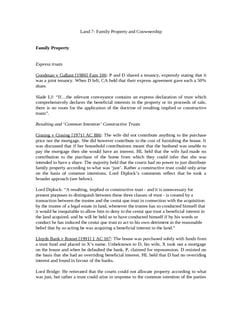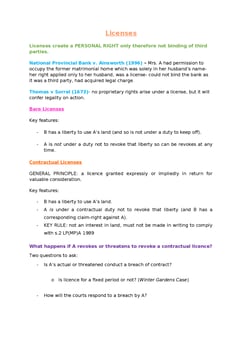AG Securities v Vaughan and Antoniades v Villiers [1990] 1 AC 417; [1988] UKHL 8
Judgement for the case AG Securities v Vaughan and Antoniades v Villiers
Table Of Contents
KEY POINTS
There can be no exclusive possession of a property or residential accommodation without joint tenancy.
Determining what constitutes joint tenancy, depends on whether the lease or tenancy agreements were created together or individually, the duration of the lease, and whether the rent is paid differently or not. A joint lease or tenancy cannot be created by individual persons, each paying a different rent for different durations of occupation. Joint tenancy cannot arise until all four unities namely title, time, possession, and interest exist.
Joint tenancy depends on whether the agreements of the occupants are interdependent (as in the case of couples, as without one, the other wouldn’t move in) or independent. There is no joint tenancy in the latter case. Thus, a look into the nature of the relationship between the occupants and whether all four unities exist or not can determine whether joint tenancy exists between the occupants.
FACTS
In this case, the appellant company, AG Securities, owned a block of flats with six living rooms, a kitchen, and a bathroom. The company converted four of the six living rooms into bedrooms, a fifth into a lounge, and a sixth into a sitting room. They aimed to provide housing to individuals who were prepared to share the flat with others, who were introduced from time to time.
The company, between 1982 and 1985, expressly entered into an agreement with the four respondents, granting each of them tenancy of one bedroom, with joint use of the lounge, sitting room, kitchen, and bathroom.
The four agreements were entered into separately and were made independent of one another. The agreements were signed on different dates, with different terms and rents. They were granted nothing more than a license to stay, asserting that no shared exclusive possession existed between the tenants.
In 1985, when AG Securities terminated all of the agreements, the tenants contended that they were joint tenants and hence were entitled to statutory protection. Thus, the case is concerned with whether the four defendants had exclusive possession and thus in relation, the joint tenancy of the entire flat.
COMMENTARY
This case highlighted that, in a residential accommodation or housing shared by two or more people, the occupants can either be licensees or tenants of the whole accommodation jointly, granting them exclusive possession; or each occupant can be a separate tenant of a particular part of the property, as agreed upon contractually. However, there can be no exclusive possession of a property or residential accommodation without joint tenancy.
Joint tenants lease the property for the same duration, with exclusive possession for a single rent payment, and each joint tenant is equally liable to the lessor. In this case, each defendant arrived independently, had different terms of occupancy, and paid separate rents.
Moreover, in the agreements between the appellant and the four respondents, the rights of the respondents were constituted in distinct and separate agreements and cannot be construed as them having joint tenancy.
It was held that the respondents only held tenancy of one room each, and that shared occupation of the flat does not grant them exclusive possession over the flat as a whole. Therefore, there was no joint tenancy between the four respondents.
ORIGINAL ANALYSIS
In the first case (AG Securities) 4 People shared a flat each under separate agreements with the landlord that were made at different rents, times and terms, and purported to give no more than contractual licence to stay, stating that there was no joint exclusive possession. This was on the understanding that the flat occupants would come and go (as they in fact did).
The other case (Villiers) involved a couple who rented a flat under what purported to be a mere contractual licence and said that the landlord could introduce a new tenant at any point (even though this would have been difficult since there was only one bedroom).
HL ruled that in the AG Securities case, there was no tenancy, but a contractual licence to share the flat with others, without exclusive possession.
In the Antoniades case, the purported right of the landlord to introduce further occupiers into the flat was a pretence to avoid the provisions of the Rent Acts, whereas in reality there had been an intention to confer on the occupants exclusive possession of the flat for a term in consideration of periodical payments.
Lord Templeman
Whether or not a device is a pretence (“sham” is no longer used) depends on whether it was “seriously intended in fact” and if it doesn’t reflect the “substance and reality of the situation”, or the parties do not consider it a term “to which any effect would be given”.
On the relationship with the Rents Acts, he says that "Since parties to an agreement cannot contract out of the Rent Acts, the grant of a tenancy to two persons jointly cannot be concealed, accidentally or by design, by the creation of two documents in the form of licences.”
He says that the courts are interested in the facts of the situation, not the labels parties agree on.
Whether or not there is joint tenancy depends on whether the contracts of the occupiers were interdependent (as in the case of a couple, since without one, the other would not move in) or independent (as in the case of loosely tied flatmates).
RELATED CASES
For Further Study on AG Securities v Vaughan and Antoniades v Villiers

Land Law notes fully updated for recent exams at Oxford and Cambridge. ...
Need instant answers? Our AI exam tutor is here to help.
Ask questions 🙋 Get answers 📔 It's simple 👁️👄👁️
Our AI is educated by the highest scoring students across all subjects and schools. Join hundreds of your peers today.
Get StartedSimilar Cases
Related Product Samples
These product samples contain the same concepts we cover in this case.
| Property Law | Co Ownership Notes (13 pages) |
| Land Law | Leases Notes (77 pages) |

 Since 2010, Oxbridge Notes has been a trusted education marketplace, supplying high-quality materials from top achievers at universities like Oxford, Cambridge, LSE, Harvard, and Yale.
Since 2010, Oxbridge Notes has been a trusted education marketplace, supplying high-quality materials from top achievers at universities like Oxford, Cambridge, LSE, Harvard, and Yale.